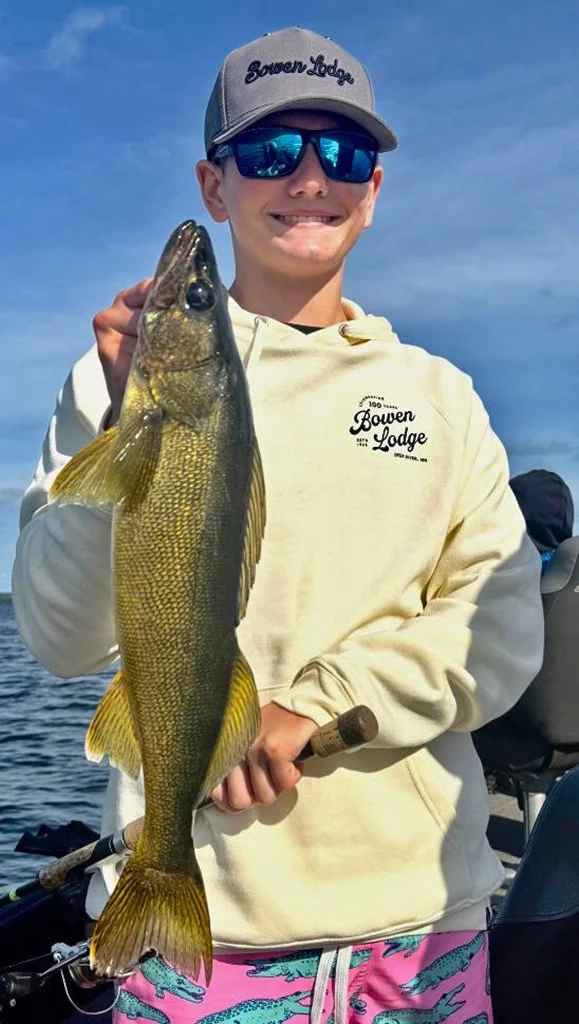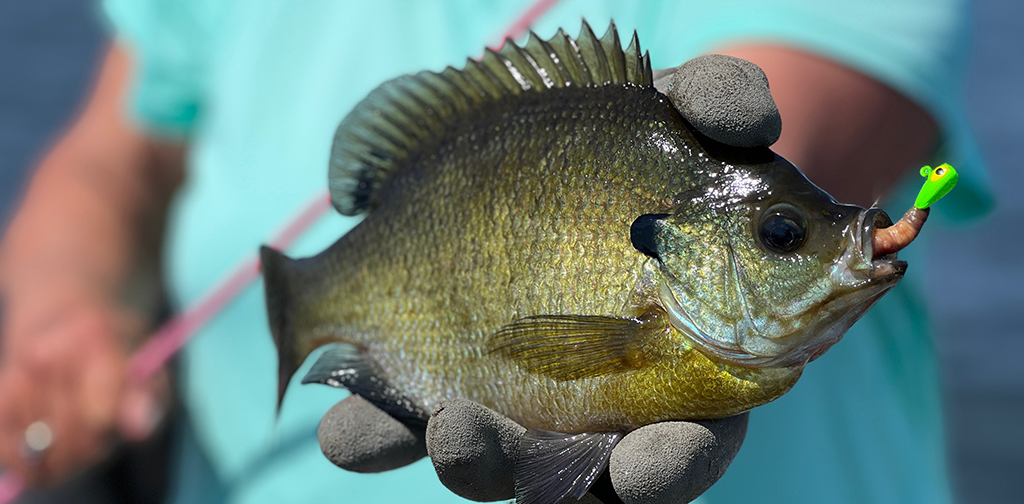We’re rolling into the Labor Day holiday weekend and fish migrations into early fall locations have begun. Walleyes are pushing toward shoreline flats, perch are becoming active, panfish and bass are feeding more often, and with greater intensity.
Photo courtesy Reed Ylitalo
Walleye fishing has been interesting, ranging between very good, and very tough, depending on when our guests try to catch them. When conditions are favorable, like on cloudy, breezy days, they go on the prowl, feeding heavily as they move along shoreline breaks. Common late summer presentations like trolling spinners, wiggle worming and jig and minnow all work well.
But amateurs and pros alike report that calm water, sunshine or post-cold-front conditions grind the daytime action to a halt. Most folks who are fishing during these times report slow going, no matter which presentation they choose.
One way to tip the scales in favor of reliable walleye action is to focus on fishing during the evening, or even after dark. The natural tendency of walleyes to feed more heavily during these times makes catching them easier. Another way to up the odds of catching walleyes is to wait for “the right day”, and fish for them when they’re most active. The previously mentioned cloudy and breezy conditions, aka walleye chop, are well known for providing the best action on Lake Winnie.
During the off times, there are other species of fish that are more than willing to provide not only action, but excellent table fare as well. Sunfish, most likely the best alternative for warm water, daytime action have been cooperative. The average size of fish has been good, with numbers of harvestable fish in the 8-to-9-inch range. Now, subject to revised limits under Minnesota’s “Quality Sunfish Initiative” there are some fish growing to larger, CPR sizes too. We can’t say that 10-inch sunfish are common yet, but there are enough of them in the system to provide you with a good chance of getting one.
During mid-summer, trolling spinners tipped with leeches or night crawlers is a good search tool for locating sunfish. Water temperatures are cooling though, now holding steady in the 70-to-72-degree range. Trolling can still help you find sunfish, but once they’re located you’ll be better off stopping the boat and fishing more deliberately, using jigs tipped with live bait. Tight lining, dropping the jig over the side of your boat is a good method for catching them. Using floats to suspend your lures in pockets between vegetation can be good too, especially on calm days. Again, small jigs tipped with cut pieces of night crawler work well.
Another great presentation for bobber fishing is to use a plain hook, paired with a few colored beads and a small, flashy spinner blade. Sunfish are curious, and the flashy blade attracts then into the area. Tipping the plain hook with live bait, like small worms, leeches or waxworms trigger them to strike.
Northern pike, fat and chunky, have been active in recent days and offer good action, and good eating too. Most folks are getting pike as they fish for other species, but late summer and early fall are historically great times to target larger fish. Casting and retrieving large lures, bobber fishing with sucker minnows, or using live bait rigs tipped with large creek chubs are all good choices.
Want a great multi-purpose game plan for chasing late summer pike? Try setting up a drift along one of Winnie’s shoreline breaks in water depths of 10 to 14 feet. As you drift, have one or two anglers casting forward, toward the shoreline using bucktails, large spoons or swimbaits. Another angler or two can slip drift using lively sucker minnows. Use large floats like Thills big fish slider, of similar large bobber set to about 6 feet deep. A ½ ounce egg sinker about 18 inches above a large, 4/0 size hook will hold the minnow in place. Often, pike attracted by the casting and retrieving will follow lures but not strike them. The lively minnows provide an alternative for them, and they are frequently caught by the drift rigs.
Largemouth bass are one fish that we don’t mention often enough. Both Cutfoot and Little Cutfoot offer excellent opportunities for catching healthy, good size bass. Even the big lake has some great spots for bass, and anglers willing to explore the outskirts of the lake in back bays and bulrush patches are amazed by the bass fishing opportunities.
During the early morning, topwater, spinnerbaits and other shallow running presentations are effective. But if you really want to catch bass here, learn how to rig and fish with weedless presentations like Texas rigged plastic worms, jigs and pigs, or large swimbaits. Casting into pockets located amongst heavy vegetation like bulrushes, coontail, cabbage and wild rice will produce quality size fish. Avoid areas of soft-mucky bottom and seek out patches of gravel, or light rocks. Most of the better bass fishing will occur here, where hard bottom and vegetation coexist.
There are crappies out there, and if you run into them, they are catchable. Moving along the shoreline breaks in water depths of 8 to 12 feet using spinners or small crankbaits will catch them. So far, nobody has reported locating large schools, or stacks of suspended fish in typical early fall locations. Will there be? It’s hard to say for sure, but the overall population of crappies appears to remain on the lower end of their range. This little fella, found in front of the boat ramp may be a clue that there was a good hatch this spring, and may well represent a future uptick in the crappie population, let’s hope so!
There are still a lot of perch on the small end of the spectrum, too small for harvest. That said, there are also schools of nice fish roaming the flats and hiding in the cabbage patches. Most of the better perch catches come from shallow water, back bays like the Third River, Raven’s Flowage, and Tamarack Bay. Trolling spinners tipped with minnows along the shallow patches of cabbage is a good search method. Once located, jigs tipped with either minnows, or a 2 inch long chunk of night crawler will help you gather a meal.
As fall sets in, begin checking areas of shallow rock and gravel on the big lake. It won’t be long before good catches of perch will come from shallow, 3 to 6 feet of water, especially on breezy, dark days. Shallow cabbage located near bulrush patches will begin producing perch soon too, so start checking areas like these as well.
Is that you saying, “I don’t care about any other fish, I just want walleyes”? Well, okay then, you’ll probably be in luck soon enough. Early every fall, we experience an uptick in the walleye action, and it does appear to be happening already. Like we said, the daytime action depends on weather conditions. Our best advice is that when it’s bright and flat, bide your time and wait to fish during the evening. When the wind starts blowing, get in the boat and go, when conditions are favorable, guides, guests and friends are reporting good walleye action right now.
Trolling spinners tipped with minnows has been reliable, so has trolling with crankbaits. Folks who have forward facing sonar are catching fish using slip floats tipped with leeches. Jigs and minnows are being used effectively by some anglers now too. Getting good minnows has not been easy, but find some golden shiners, rainbows or the largest fatheads you can get, they will work, at least for the time being.
Labor Day marks the transition between the family vacation period, and the arrival of more serious anglers. As the fishing traffic intensifies, we’ll keep you up-to-speed about walleye migrations, fishing patterns and the best presentations. Stay in touch, we’ll be here for you. And by the way, if you’re in the area, stop by the lodge for a visit, we’d be happy to let you in on the freshest news from the lakes.




